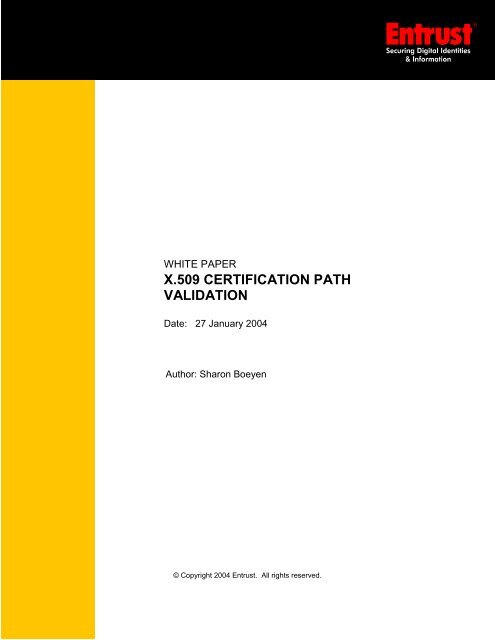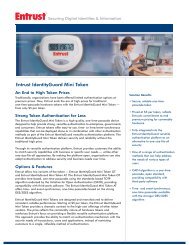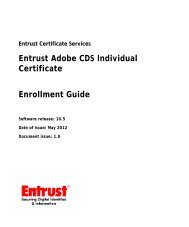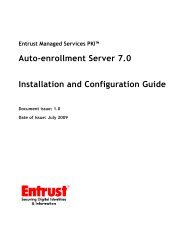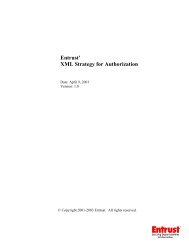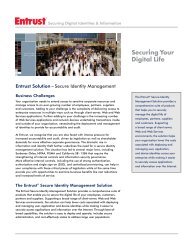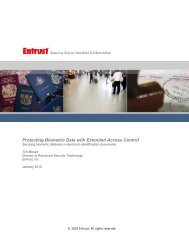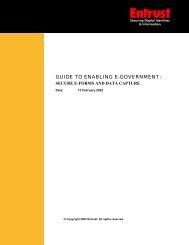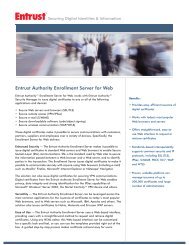X.509 Certification Path Validation - Entrust
X.509 Certification Path Validation - Entrust
X.509 Certification Path Validation - Entrust
Create successful ePaper yourself
Turn your PDF publications into a flip-book with our unique Google optimized e-Paper software.
WHITE PAPER<br />
<strong>X.509</strong> CERTIFICATION PATH<br />
VALIDATION<br />
Date: 27 January 2004<br />
Author: Sharon Boeyen<br />
© Copyright 2004 <strong>Entrust</strong>. All rights reserved.
<strong>X.509</strong> certification path validation<br />
<strong>Entrust</strong> is a registered trademark of <strong>Entrust</strong>, Inc. in the United States and certain other<br />
countries. In Canada, <strong>Entrust</strong> is a registered trademark of <strong>Entrust</strong> Limited. All <strong>Entrust</strong> product<br />
names are trademarks of <strong>Entrust</strong>, Inc. or <strong>Entrust</strong> Limited. All other company and product<br />
names are trademarks or registered trademarks of their respective owners.<br />
The material provided in this document is for information purposes only. It is not intended to be<br />
advice. ENTRUST DOES NOT WARRANT THE QUALITY, ACCURACY OR COMPLETENESS OF<br />
THE INFORMATION CONTAINED IN THIS ARTICLE. SUCH INFORMATION IS PROVIDED "AS<br />
IS" WITHOUT ANY REPRESENTATIONS, WARRANTIES AND/OR CONDITIONS OF ANY KIND,<br />
WHETHER EXPRESS, IMPLIED, STATUTORY, BY USAGE OF TRADE, OR OTHERWISE, AND<br />
ENTRUST SPECIFICALLY DISCLAIMS ANY AND ALL REPRESENTATIONS, WARRANTIES<br />
AND/OR CONDITIONS OF MERCHANTABILITY, SATISFACTORY QUALITY, TITLE,<br />
NON-INFRINGEMENT, OR FITNESS FOR A SPECIFIC PURPOSE.<br />
© Copyright 2004 <strong>Entrust</strong>. www.entrust.com<br />
All rights reserved.<br />
Page i
<strong>X.509</strong> certification path validation<br />
TABLE OF CONTENTS<br />
1. ABSTRACT.......................................................................................................................... 1<br />
2. INTRODUCTION.................................................................................................................. 2<br />
2.1 PKI ENTITIES................................................................................................................. 2<br />
2.2 RELYING PARTY TRUST .............................................................................................. 3<br />
2.3 BUSINESS CONTROLS................................................................................................. 4<br />
2.4 CERTIFICATE EXTENSIONS ........................................................................................ 4<br />
3. PATH VALIDATION............................................................................................................. 6<br />
3.1 PATH VALIDATION INPUTS.......................................................................................... 6<br />
3.1.1 Trust Anchor ....................................................................................................... 6<br />
3.1.2 <strong>Certification</strong> <strong>Path</strong>................................................................................................. 7<br />
3.1.3 Revocation Status Information ............................................................................ 7<br />
3.1.4 Process Constraints ............................................................................................ 7<br />
3.2 THE PATH VALIDATION PROCESS.............................................................................. 8<br />
3.2.1 <strong>Path</strong> Structure Processes.................................................................................... 8<br />
3.2.2 Certificate Validity Processes .............................................................................. 8<br />
3.2.3 Business Controls Processes.............................................................................. 9<br />
3.3 PROCESS OUTPUTS .................................................................................................. 11<br />
4. CONFORMANCE............................................................................................................... 12<br />
5. CURRENT STATUS........................................................................................................... 13<br />
6. SUMMARY/CONCLUSIONS.............................................................................................. 14<br />
7. REFERENCES................................................................................................................... 16<br />
8. ABOUT ENTRUST............................................................................................................. 17<br />
© Copyright 2004 <strong>Entrust</strong>. www.entrust.com<br />
All rights reserved.<br />
Page ii
<strong>X.509</strong> certification path validation Abstract<br />
1. ABSTRACT<br />
Public-key infrastructure enables authentication in federated environments. Management of that<br />
federation needs to be considered when planning PKI deployment, to ensure users and assets are<br />
adequately protected. [<strong>X.509</strong>] defines a standard set of business controls that can be imposed to manage<br />
the extent of federation. <strong>Certification</strong> path validation is the set of standard processes that<br />
users/applications relying on public-key certificates execute to determine their trustworthiness and<br />
acceptability. This includes ensuring all relevant business controls are respected. This paper describes<br />
the path validation process and how the business controls can be used to manage the extent of<br />
federation.<br />
© Copyright 2004 <strong>Entrust</strong>. www.entrust.com<br />
All rights reserved. Page 1
<strong>X.509</strong> certification path validation Introduction<br />
2. INTRODUCTION<br />
[<strong>X.509</strong>] defines an authentication infrastructure based on public-key techniques. It performs implicit<br />
authentication using data encryption and explicit authentication using digital signature. [<strong>X.509</strong>] has been<br />
developed for use in federated environments. For this reason it defines sophisticated controls for<br />
managing the extent of federation. <strong>Path</strong> validation ensures that the controls are enforced and the extent<br />
of federation appropriately managed.<br />
2.1 PKI ENTITIES<br />
The basic entities involved in the enablement of secure and trusted transactions in a Public Key<br />
Infrastructure (PKI) are:<br />
a) <strong>Certification</strong> Authority (CA)<br />
b) Subscriber<br />
c) Relying party<br />
d) Policy Authority (PA)<br />
The CA issues <strong>X.509</strong> public-key certificates to subscribers, binding their identities to the public keys. A<br />
CA may also manage the life-cycle of those certificates including their expiration, renewal and revocation.<br />
The subscriber is the holder of keys/certificates for use as electronic credentials. The relying party is the<br />
entity that uses subscriber certificates to establish trust and security for electronic transactions. The PA is<br />
the individual/group that establishes and manages the domain security policies under which all entities in<br />
the domain operate. The PA sets policy and procedures under which the CA operates. This includes the<br />
certificate policy definitions, the <strong>Certification</strong> Practice Statement (CPS) for the CA’s management of<br />
certificates and subscriber agreements. The subscriber agreement specifies the responsibilities and<br />
procedures for subscribers with respect to protection of their private keys, reporting lost/compromised<br />
keys as well any restrictions on the use of their keys and certificates. The relying party policy establishes<br />
the rules for acceptance of certificates. Together this set of policies establishes control over federation for<br />
the PKI administrative. A PKI administrative domain is a set of PKI entities operating under uniform<br />
domain security policy as established by its PA. Automation of some PA functions can be managed<br />
centrally through the same system that operates the CA, however logically these are two distinct entities.<br />
Figure 1 illustrates these relationships among entities in a PKI administrative domain.<br />
© Copyright 2004 <strong>Entrust</strong>. www.entrust.com<br />
All rights reserved. Page 2
<strong>X.509</strong> certification path validation Introduction<br />
PA<br />
CP/CPS<br />
Relying<br />
Party Policy<br />
CA<br />
Subscriber<br />
Agreement<br />
Revocation<br />
Status<br />
Certificate<br />
Relying<br />
Party<br />
Transaction<br />
Subscriber<br />
Figure 1: PKI Entities<br />
2.2 RELYING PARTY TRUST<br />
The primary focus for an organization deploying PKI is the protection of its own assets and protection of<br />
its users as both subscribers and relying parties. As relying parties, users make use of certificates to<br />
authenticate subscribers to some service, to accept a business commitment such as a purchase order, to<br />
ensure transmitted data is authentic and has not been altered and to enable privacy through encryption.<br />
Relying parties may be human users or application systems.<br />
Relying parties should not blindly trust any and all issued certificates however. Before placing trust in a<br />
certificate, relying parties must create and validate a certification path. A certification path is a sequence<br />
of certificates beginning with a certificate issued by a known CA whose public key is already trusted by<br />
the relying party (trust anchor) and ending with a certificate issued to the subscriber. A valid certification<br />
path conforms to domain policy. If the subscriber’s certificate was issued by the CA that is the relying<br />
party’s trust anchor, the certification path comprises only that single certificate. Otherwise, the<br />
subscriber’s certificate is preceded in the path by a sequence of CA certificates (certificates that have<br />
CAs as both the issuer and subject).<br />
In federated environments PKI administrative domains establish relationships that enable relying parties<br />
in one domain to trust subscriber certificates issued in a different domain. In these situations, the<br />
certification path includes a CA certificate issued by a CA in the relying party domain to a CA in a<br />
federated domain. There may be additional CA certificates, issued by federated CAs to other federated<br />
CAs, if for example the subscriber is in a domain that is only indirectly federated with the relying party<br />
domain.<br />
<strong>Certification</strong> path validation is the set of processes that ensures the path is properly structured, each<br />
certificate in the path is valid, and the subscriber’s certificate is acceptable and appropriate for the<br />
intended use. Use of the subscriber’s certificate must be done in compliance with the relevant policies of<br />
the relying party’s domain as well as in compliance with the policies imposed on use of their certificates<br />
by PAs in all federated domains in the certification path.<br />
© Copyright 2004 <strong>Entrust</strong>. www.entrust.com<br />
All rights reserved. Page 3
<strong>X.509</strong> certification path validation Introduction<br />
2.3 BUSINESS CONTROLS<br />
The PA may determine that relying parties in their community are permitted to trust only a subset of the<br />
certificates in the federation. This occurs most frequently in federated environments where remote CAs<br />
may issue certificates under policies deemed unacceptable by the local PA. In such cases, business<br />
controls can be used to place boundaries around the set of acceptable certificates, thereby controlling the<br />
extent of federation. These business controls are realized as extensions included in CA certificates issued<br />
by CAs in each domain. [<strong>X.509</strong>] and [PKIX] define a standard set of extensions specifically for this<br />
purpose. The use of certificate extensions to represent business controls in CA certificates is referred to<br />
as “infrastructure constraints” in this paper. In a federated environment, for example, infrastructure<br />
constraints can be used to limit the set of acceptable certificates issued in a remote domain to only those<br />
issued under a specific certificate policy or to a specific set of subjects. Since a certification path can<br />
include multiple CA certificates that span several federated CAs, several sets of infrastructure constraints<br />
may appear in a single certification path. Each CA in the path can impose a set of infrastructure<br />
constraints that limit the acceptability of subsequent certificates in the path in accordance with their own<br />
policy as established by their PA.<br />
If all relying parties in a domain operate under identical policy, the policy can be enforced by infrastructure<br />
constraints in certificates issued by the local CA. However this is not always the case. For example, in a<br />
corporate setting, it may be that employees in the legal department can only accept digital signatures on<br />
contracts if the signer’s certificate was issued under a “high assurance” policy, but all employees can<br />
accept digitally signed email content if the signer’s certificate was issued under a high or medium<br />
assurance level policy. Infrastructure constraints cannot completely address this requirement. The PA<br />
needs the ability to partition the relying party community to impose additional constraints, over and above<br />
those imposed by the more generic infrastructure constraints, on some instances of path validation.<br />
[<strong>X.509</strong>] specifies a set of configurable initialization parameters for the path validation process. The<br />
tailoring of these parameters to satisfy the needs of a partitioned relying party community is referred to in<br />
this paper as “process constraints”.<br />
The PA must be able to adapt its policy to changes in the environment and modify the conditions under<br />
which it’s local relying parties conduct path validation as the set of relationships with external CAs<br />
changes and as the nature of applications and transactions used by local relying parties changes. In<br />
order to maintain authority over its domain, process constraints should be managed by the authority<br />
through automated means thereby ensuring that individual relying parties do not deliberately or<br />
inadvertently circumvent the local security policy. While local policy may be managed centrally through<br />
the same system that operates the CA, the PA function is logically a distinct function.<br />
Together, infrastructure constraints and process constraints enable standards compliant path validation<br />
processes to ensure that the relevant business controls imposed in the relying party domain, as well as<br />
those imposed in federated domains are respected. As a result only certificates that are compliant with<br />
the policies of each of those domains will be accepted by relying parties.<br />
2.4 CERTIFICATE EXTENSIONS<br />
There is a set of standard certificate extensions defined in [<strong>X.509</strong>] and [PKIX]. The majority of these play<br />
a role in the path validation process. Most are used to convey infrastructure constraints. Others are used<br />
in the processes that ensure a certification path is properly structured or to ensure that a specific<br />
certificate is valid in its own right. Figure 2 provides an outline of this set of certificate extensions and the<br />
role they play in path validation. Each of these is described in more detail in Section 3.<br />
Extension <strong>Path</strong> Structure Certificate Validity Business Controls<br />
Authority key identifier Key chaining<br />
Subject key identifier Key chaining<br />
Basic constraints Entity type <strong>Path</strong> length control<br />
Key usage Appropriate key check<br />
© Copyright 2004 <strong>Entrust</strong>. www.entrust.com<br />
All rights reserved. Page 4
<strong>X.509</strong> certification path validation Introduction<br />
Certificate policies<br />
Policy mappings<br />
Policy constraints<br />
Inhibit any policy<br />
Name constraints<br />
Subject alternative name<br />
Policy controls<br />
Policy controls<br />
Policy controls<br />
Policy controls<br />
Name controls<br />
Name controls<br />
Figure 2: <strong>Path</strong> <strong>Validation</strong> Extensions<br />
The remaining standard certificate extensions serve other purposes, such as guidance for path<br />
development or support in locating revocation information. Those extensions are therefore outside the<br />
scope of this paper. However, for completeness they are listed below. Note that additional extensions can<br />
be defined by other groups for other purposes but those extensions would not have a role in standard<br />
path validation.<br />
• Authority information access<br />
• CRL distribution points<br />
• Extended key usage<br />
• Freshest CRL<br />
• Issuer alternative name<br />
• Private key usage period<br />
• Subject directory attributes<br />
• Subject information access<br />
There is also a standard set of extensions that appear in CRLs rather than certificates. These are not<br />
listed here but can be found in [<strong>X.509</strong>] and [PKIX].<br />
© Copyright 2004 <strong>Entrust</strong>. www.entrust.com<br />
All rights reserved. Page 5
<strong>X.509</strong> certification path validation <strong>Path</strong> validation<br />
3. PATH VALIDATION<br />
Within this paper, path validation is defined as the set of processes undertaken by the relying party to<br />
verify the integrity, trustworthiness and appropriateness of all certificates in a certification path, including<br />
the certificate issued to the subscriber. [<strong>X.509</strong>] describes all of these processes as necessary for the<br />
relying party, however only a subset are included in the “path processing procedures” portion of the<br />
standard. This paper combines the complete set of processes under the umbrella of “path validation” to<br />
provide a complete view of the processing necessary before a relying party trusts a subscriber certificate.<br />
<strong>Path</strong> validation includes a set of process inputs, the processes themselves, and a set of process outputs.<br />
The processes themselves include checks to ensure that the certification path is a properly built path<br />
according to the [<strong>X.509</strong>] requirements, basic certificate checks that are performed against each certificate<br />
in the path, and a set of business controls checks to ensure that relying on the subscriber’s certificate<br />
would adhere to the constraints put upon certificates in the path by the local PA as well as by all<br />
authorities that issued certificates included in the path.<br />
INPUTS<br />
Trust Anchor<br />
Public Key<br />
<strong>Certification</strong><br />
<strong>Path</strong><br />
Revocation<br />
Information<br />
Process<br />
Constraints<br />
PROCESSES<br />
<strong>Path</strong> Structure<br />
Processes<br />
Certificate<br />
Validity<br />
Business<br />
Controls<br />
OUTPUT<br />
Success Indication<br />
& process details<br />
OR<br />
Failure Indication<br />
& Reason<br />
Figure 3: <strong>Path</strong> <strong>Validation</strong> Outline<br />
3.1 PATH VALIDATION INPUTS<br />
In addition to the certification path itself, the path validation process requires the relying party’s trust<br />
anchor public key, revocation status information for each certificate in the path, and any process<br />
constraints relevant to the particular instance of path validation to tailor it to the policy environment in<br />
which the transaction is being executed (see Section 3.1.4).<br />
3.1.1 Trust Anchor<br />
A trust anchor is a CA that is trusted by the relying party and its public key is the basis upon which other<br />
trust decisions are made. There are a number of out-of-band schemes that can be used to convey trust<br />
anchor public keys to relying parties. These schemes need to ensure that relying parties are securely<br />
provided with the appropriate trust anchor public keys and that relying parties do not make use of CA<br />
public keys that may be conveyed through unapproved mechanisms. For example some PAs may restrict<br />
their relying party community to using a single trust anchor, the local CA, for all instances of path<br />
validation. In other environments, the PA may approve use of some/all trust anchors whose root keys are<br />
© Copyright 2004 <strong>Entrust</strong>. www.entrust.com<br />
All rights reserved. Page 6
<strong>X.509</strong> certification path validation <strong>Path</strong> validation<br />
pre-installed in popular browsers. There are additional schemes for conveying approved trust anchors<br />
and their public keys but specific schemes are outside the scope of this paper.<br />
3.1.2 <strong>Certification</strong> <strong>Path</strong><br />
A certification path is a sequence of one or more certificates, with each certificate forming a link in a chain<br />
from the relying party’s trust anchor to the subscriber’s public key. In the special case where the relying<br />
party’s trust anchor also issued the subscriber’s certificate, the certification path consists of a single<br />
certificate, the subscriber’s certificate. In some applications, such as S/MIME, a certification path or a<br />
portion of a certification path may be provided to the relying party by the subscriber. In other<br />
environments, the relying party must locate and retrieve the necessary certificates from some<br />
repositories. <strong>Certification</strong> path development techniques are outside the scope of this paper.<br />
3.1.3 Revocation Status Information<br />
In many environments, the CA is responsible for managing the life-cycle of the certificates it issues,<br />
including revoking those certificates if they are no longer to be relied upon, perhaps because the<br />
subscriber no longer meets the requirements for membership of the domain. If a certificate is revoked, the<br />
certificate issuing CA generally makes this status change available on a Certificate Revocation List (CRL).<br />
Revocation status can be communicated to relying parties through mechanisms other than CRLs but<br />
specific schemes are outside the scope of this paper. CRLs are updated on a regular basis enabling<br />
relying parties to determine the status at the start of the current window. CRLs may be used directly by<br />
relying parties or indirectly through servers that provide responses to revocation status queries. In other<br />
environments CAs may not perform revocation of certificates, but must make that information available to<br />
relying parties so they have that revocation status for certificates. Current revocation status information is<br />
required for each of the certificates in the certification path. Specific techniques for relying parties to<br />
obtain revocation status information are outside the scope of this paper.<br />
3.1.4 Process Constraints<br />
Process constraints are used to partition the relying party community to support differing policies among<br />
them. This partitioning may be done on the basis of a set of relying parties, on the basis of the application<br />
they use or even on the basis of specific transactions, depending on the requirements of the policy.<br />
Process constraints further restrict the acceptable set of certificates from that constrained by<br />
infrastructure constraints.<br />
While the most obvious environment for use of process constraints is in a federated environment where<br />
the goal is to restrict relying parties to trusting only a subset of the entities in the federation, there are<br />
other uses that can be made of process constraints. Process constraints can be used, for instance to<br />
enable a simple authorization service. If role information is included in subscriber certificates, relying<br />
parties can authenticate the subscriber as well as make basic authorization decisions based upon the<br />
subscriber’s authenticated identity and/or associated role information. <strong>Path</strong> validation, with an appropriate<br />
set of business controls, automatically provides this service. For example, assume that ABC Corp order<br />
entry system has a requirement to accept transactions from only XYZ Corp subscribers in the accounts<br />
payable area. The role of XYZ Corp employees may be indicated in their certificates explicitly through a<br />
certificate policy identifier. Process constraints can be used to restrict access to the order entry system to<br />
only those subscribers authenticating with an appropriate certificate.<br />
Process constraints can also play a role within a single CA, non-federated, PKI. In this situation, there is<br />
no opportunity to impose infrastructure constraints so process constraints are the only way to impose<br />
restrictions on path validation. For example, assume a single CA PKI where the CA issues authentication<br />
certificates to users for use with a number of web-based electronic services. Some users, by design, may<br />
have credentials that can only be used to authenticate to a single specific service, while other users may<br />
have credentials that can be used for authenticating to all such services. In this example the service<br />
applications are relying parties when they perform certification path validation to ensure users are<br />
properly authenticated. Each such service may use process constraints to ensure that only certificates<br />
issued under specific certificate policies will be trusted.<br />
© Copyright 2004 <strong>Entrust</strong>. www.entrust.com<br />
All rights reserved. Page 7
<strong>X.509</strong> certification path validation <strong>Path</strong> validation<br />
3.2 THE PATH VALIDATION PROCESS<br />
The path validation process consists of a number of individual processes that fall into three basic<br />
categories: path structure, certificate validity and business controls. There is no specific order in which the<br />
individual processes must be executed. However, because many of the business controls imposed<br />
through infrastructure constraints affect subsequent certificates in the path, there is a requirement to<br />
process certificates in the exact order they appear in the path beginning with the certificate that was<br />
signed by the relying party’s trust anchor and ending with the subscriber certificate. [<strong>X.509</strong>] and [PKIX]<br />
both include an outline of a procedure for path validation in their standards. While standard conformance<br />
demands that an implementation be functionally equivalent to the external behavior resulting from those<br />
outlines, it is not mandatory for implementations to use either of those algorithms directly.<br />
3.2.1 <strong>Path</strong> Structure Processes<br />
<strong>Path</strong> structure processing consists of four tests. These tests ensure that the certification path is properly<br />
constructed. If all certificates in the path pass these tests, then the certification path is a proper path in<br />
that the intermediate entities are all CAs and the path forms an unbroken chain of certificates to the<br />
subscriber public key. If any of these individual processes fails, then the path validation process fails.<br />
3.2.1.1 Name Chaining<br />
Name chaining involves comparing the value of the subject field in one certificate with the issuer field in<br />
the subsequent certificate. For each pair of adjacent certificates in the path, these values must match.<br />
This check ensures that the certification path is truly an unbroken chain of entities relating directly to one<br />
another and that it has no missing links.<br />
3.2.1.2 Key Chaining<br />
Key chaining involves checking that the key certified in each certificate verifies the digital signature on the<br />
subsequent certificate. This check establishes cryptographic trust from the relying party’s trust anchor to<br />
the subscriber’s public key. Ensuring that the value of the subjectKeyIdentifier extension in one<br />
certificate matches the value of the issuerKeyIdentifier extension in the subsequent certificate<br />
contributes to the key chaining process.<br />
3.2.1.3 Duplicate Certificates<br />
The duplicate certificate process involves checking to ensure that each certificate appears only once in<br />
the path. If the path includes two certificates that have matching issuer names and identical serial<br />
numbers, then they are considered duplicates. This check ensures that a loop does not adversely alter<br />
the effect of business controls, changing the outcome of proper path validation. For example, a duplicate<br />
certificate could impact the path length controls (see Section 3.2.3.3).<br />
3.2.1.4 Subject Entity Type<br />
CAs are the only legitimate issuers of certificates. Therefore, each certificate in the path, except the<br />
subscriber’s certificate, needs to be checked to ensure that its subject is also a CA. This check is<br />
performed by ensuring that the basicConstraints extension is present in the certificate, with the cA<br />
element set to TRUE. For some transactions, such as verifying the digital signature on a CRL, the<br />
subscriber of interest is itself a CA while in most other transactions the subscriber of interest is not a CA.<br />
Therefore this check is not required on the subscriber’s certificate.<br />
3.2.2 Certificate Validity Processes<br />
Certificate validity processing ensures that each certificate is a valid <strong>X.509</strong> public-key certificate and that<br />
the basic requirements for use of the public key are satisfied. If any of these processes results in failure<br />
for any certificate in the path, the path validation process fails.<br />
3.2.2.1 Syntax Check<br />
The syntax for certificates is defined in [<strong>X.509</strong>]. This includes a set of base certificate fields and an<br />
extension capability that enables additional information to be conveyed. Each certificate extension defines<br />
its own syntax. A standard set of extensions is specified in [<strong>X.509</strong>] and [PKIX]. The syntax of all base<br />
certificate fields as well as all known extensions must be checked to ensure the syntax of each conforms<br />
© Copyright 2004 <strong>Entrust</strong>. www.entrust.com<br />
All rights reserved. Page 8
<strong>X.509</strong> certification path validation <strong>Path</strong> validation<br />
to the standards. If there are unknown extensions present, their syntax need not (and cannot) be<br />
checked.<br />
3.2.2.2 Integrity Check<br />
The integrity of each certificate must be verified to ensure that certificate content has not been altered<br />
from that signed by the CA. This check involves verifying the digital signature on the certificate. If the<br />
signature on any certificate in the path fails to verify, then that certificate has been corrupted and cannot<br />
be trusted.<br />
3.2.2.3 Validity Period Check<br />
Each certificate includes a validity period indicating the window of time during which the certified public<br />
key is considered valid for use. Generally, the certificate validity period is compared against the current<br />
time. However, there are some circumstances when the certificate validity period is compared to a time in<br />
the past.<br />
3.2.2.4 Revocation Check<br />
Even if all certificates are within their validity period, it is possible that one or more may have been<br />
revoked by its issuer. Current revocation status information must be checked for each certificate in the<br />
path. For example, this process could ensure a relying party did not accept the signature of a recently<br />
dismissed disgruntled employee on a business transaction.<br />
3.2.2.5 Criticality Check<br />
All certificate extensions include an indication of whether their processing is critical to the acceptance of<br />
that certificate for use. The criticality flag provides a backward/forward compatibility mechanism that<br />
enables CAs to state what should happen when a relying party that does not yet support the new<br />
extension encounters it. If an extension is flagged critical, but the relying party path validation process<br />
does not support that extension, then the certificate cannot be used. Unknown non-critical extensions can<br />
safely be ignored and other processing continued. This process prevents relying parties from trusting a<br />
certificate under conditions that its issuer did not intend. Often the policy under which a certificate was<br />
issued will free its issuer from liability if the certificate is not used according to the issuer’s specific policy,<br />
including processing all critical extensions in the certificate.<br />
3.2.2.6 Key Usage Check<br />
The keyUsage certificate extension is the mechanism used by the issuing CA to indicate the general use<br />
for the public key. For the subscriber’s certificate this may be set to any one of a number of values. For<br />
example, if the key can be used for client authentication, the keyUsage extension would have the<br />
“digitalSignature” indicator set. If this is the only indicator set, such a certificate would not be appropriate<br />
for encrypting data for that subscriber. All other certificates in the path must have the keyCertSign<br />
indicator set in their keyUsage extension, indicating that these certificates can be used to verify the<br />
subject CA’s signature on subsequent certificates.<br />
3.2.3 Business Controls Processes<br />
Business controls processes ensure that all certificates in the path adhere to business and policy<br />
constraints imposed on the path validation process through infrastructure constraints and/or process<br />
constraints. Process constraints are introduced at the beginning of the path validation process through<br />
initialization of a set of process variables. As such, process constraints automatically apply to the<br />
complete set of certificates in the path. There is no criticality flag associated with process constraints. All<br />
process constraints are treated as if flagged critical and must be adhered to. Most infrastructure<br />
constraints apply only to subsequent certificates, but some also impact the complete set of certificates in<br />
the path. Some infrastructure constraints can be flagged non-critical allowing unknown extensions to be<br />
ignored by relying party path validation processes that do not support them. Generally, if infrastructure<br />
constraints are flagged non-critical it is because the CA is introducing a new extension and anticipates a<br />
large community of relying parties that cannot process the extension. In this case the CA is stating that<br />
relying parties that do not yet support processing of the new extension can ignore its presence and<br />
proceed with the remaining processing.<br />
© Copyright 2004 <strong>Entrust</strong>. www.entrust.com<br />
All rights reserved. Page 9
<strong>X.509</strong> certification path validation <strong>Path</strong> validation<br />
The set of standard business controls can be broadly categorized as constraints imposed through<br />
naming, policy and length of acceptable certification paths. All of the specific controls listed below for<br />
each of these categories can be imposed as infrastructure constraints. A subset of these can also be<br />
imposed as process constraints. Infrastructure constraints can only be included in CA certificates. Using<br />
both techniques together, a CA can issue certificates to remote CAs that impose basic business controls<br />
uniformly applicable to the complete set of relying parties and use process constraints to further tailor the<br />
set of acceptable external certificates to the specific needs of relying parties, applications and<br />
transactions. Process constraints further limit the set of acceptable certificates to a subset of those<br />
acceptable under infrastructure constraints. If any of these individual constraints is present and<br />
supported but processing fails, then path validation fails. <strong>Path</strong> validation also fails if any individual<br />
constraint is present, flagged critical, but its processing is not supported.<br />
3.2.3.1 Name Controls<br />
[<strong>X.509</strong>] is based on the premise that all authorities that are “reachable” from a trust anchor operate a<br />
consistent naming scheme that results in no particular name being assigned to more than one entity. In<br />
order to ensure that certificate subject names are unambiguous, they are generally assigned within a<br />
hierarchical structure. Several nameforms, such as distinguished names, rfc822 names, DNS names, etc,<br />
are part of natural hierarchies given their fundamental syntax and structure. Name constraint business<br />
controls enable constraints of the following types to be specified:<br />
• Any subject names of a specified nameform must be within nominated permitted subtrees in the<br />
hierarchy for that nameform;<br />
• Any subject names of a specified nameform must not be within nominated “excluded subtrees” in<br />
the hierarchy for that nameform; and<br />
• Only certificates that include names of a specified nameform are acceptable (note that this is a<br />
recent addition to the standards and not yet widely supported).<br />
All three types of name constraint can be combined. At present, the standards only allow name controls<br />
to be specified as infrastructure constraints by setting the relevant fields of the nameConstraints<br />
extension. Work is currently underway to extend the standards to enable name controls as process<br />
constraints.<br />
3.2.3.2 Policy Controls<br />
Certificate policy is the standardized mechanism used by a CA to indicate the applicability of a certificate<br />
to a particular community and/or class of application with common security requirements, such as the<br />
authentication of a user to a home-banking application or the encryption of email messages among<br />
federal government employees. Each certificate policy has a unique identifier. Certificates may be issued<br />
under one or more policies as indicated in the certificatePolicies extension of that certificate. If two PKI<br />
administrative domains issue certificates under equivalent certificate policies, but use different identifiers<br />
for those policies, then they can equate those identifiers through the policyMapping extension in the<br />
cross-certificates issued between those CAs. The certificatePolicies extension can be included in both<br />
subscriber and CA certificates. The policyMapping extension can only be included in CA certificates.<br />
Unless otherwise constrained, a remote policy, mapped to an equivalent local policy, would be<br />
considered a match for its equivalent local policy. There is also a special identifier for “anyPolicy” that,<br />
can be included in certificates. Unless policy mapping has been inhibited by a related business control<br />
described below, this identifier is considered a match for any specific policy identifier. These two<br />
certificate extensions are the basic tools with which a number of policy-related constraints can be built.<br />
As with other extensions, any policy related controls implemented as non-critical infrastructure constraints<br />
can be ignored by relying party path validation systems that do not support those extensions. The<br />
descriptions below assume that the extensions are supported by the relying party system.<br />
One of the policy controls that can be imposed on path validation is that all certificates be issued under at<br />
least one common policy, without necessarily specifying a particular policy. This control can be imposed<br />
as an infrastructure constraint by setting the requireExplicitPolicy field of the policyConstraints<br />
extension and/or as a process constraint by setting the explicit-policy-indicator variable.<br />
© Copyright 2004 <strong>Entrust</strong>. www.entrust.com<br />
All rights reserved. Page 10
<strong>X.509</strong> certification path validation <strong>Path</strong> validation<br />
An additional control can be imposed limiting acceptable certificate policies to those issued under a<br />
specific set of identified policies. This control can be imposed as an infrastructure constraint by including<br />
a specific set of policy identifiers in the certificatePolicies extension and/or as a process constraint by<br />
initializing the initial-policy-set to the policies of interest.<br />
Policy controls also enable the inhibiting of policy mappings. If this control is set, and if policy is required<br />
as discussed above, all certificates in the path must contain at least one identical policy identifier. Mapped<br />
policy identifiers are no longer considered acceptable matches in this case. This control can be imposed<br />
as an infrastructure constraint by setting the inhibitPolicyMapping field of the policyConstraints<br />
extension. In this case it impacts subsequent certificates only. This control can also be imposed as a<br />
process constraint by setting the policy-mapping-inhibit-indicator, in which case it impacts all certificates<br />
in the path.<br />
As mentioned earlier, there is a special identifier for “anyPolicy” that is considered a match for any<br />
specific policy identifier. Note, however, that policy mappings are never permitted to/from this identifier.<br />
While this “wildcard” identifier does serve a purpose in some environments, there are many environments<br />
where it is considered harmful, in which case specific identifiers must be used. The final policy-related<br />
control outlaws the anyPolicy identifier. This control can be imposed as an infrastructure constraint by<br />
including the inhibitAnyPolicy extension. In this case it impacts subsequent certificates only. This<br />
control can also be imposed as a process constraint by setting the inhibit-any-policy-indicator, in which<br />
case it impacts all certificates in the path.<br />
3.2.3.3 <strong>Path</strong> Length Controls<br />
The final standardized business control enables CAs to constrain the length of a certification path. If one<br />
CA imposes a constraint on the acceptable length of a certification path, subsequent certificates in the<br />
path can only further reduce the acceptable length. <strong>Path</strong> length constraints in subsequent certificates that<br />
have a higher value must be ignored. At present, the base standards only enable this control as an<br />
infrastructure constraint through the inclusion of a basicConstraints extension with the<br />
pathLenConstraint field present. There is no corresponding process constraint.<br />
3.3 PROCESS OUTPUTS<br />
The path validation process results in either success or failure.<br />
Success indicates that the subscriber’s certificate, based on the inputs to the process, is acceptable for<br />
the intended use. Specifically:<br />
• The path was properly constructed and all tests in section 3.2.1 passed;<br />
• All certificates in the path are considered valid and all tests in section 3.2.2 passed; and<br />
• All business controls imposed as process constraints as well as in infrastructure constraints have<br />
been satisfied. The only exception to this is where infrastructure constraints are included as noncritical<br />
extensions that are not supported by the relying party. In this case path validation still<br />
succeeds but some non-essential business controls have been ignored.<br />
If path validation succeeds, then the output includes a list of certificate policy identifiers (if any) that were<br />
common to all certificates, an indication of any policy mappings that occurred during the process and an<br />
indication of whether the presence of policy identifiers in all certificates was a business control that had<br />
been imposed on the process for this specific path, either as a process constraint or an infrastructure<br />
constraint.<br />
<strong>Path</strong> validation failure results if any one of the tests described in 3.2.1, 3.2.2 or 3.2.3 fails. If path<br />
validation fails, then the output includes an indication of the reason for failure. A subscriber key for which<br />
no valid path can be found should not be used by the relying party.<br />
© Copyright 2004 <strong>Entrust</strong>. www.entrust.com<br />
All rights reserved. Page 11
<strong>X.509</strong> certification path validation Conformance<br />
4. CONFORMANCE<br />
<strong>Path</strong> validation is a critical element of protecting the interests of relying parties and ensuring that relying<br />
parties use only certificates that comply with the security policy of their local PA as well as that of all PAs<br />
of domains represented in the certification path. In addition to ensuring that relying party path validation<br />
systems being deployed satisfy the functional requirements of the local domain, another critical factor is<br />
ensuring that the systems being deployed are actually performing these processes in compliance with the<br />
definitions for path validation standardized in [<strong>X.509</strong>] and [PKIX]. The path validation process is a<br />
relatively complex process and until recently there has not been a comprehensive test suite available to<br />
assess conformance. In 2003 the National Institute of Standards and Technology (NIST), together with<br />
the National Security Agency (NSA) and DigitalNet, produced a test suite that tests path validation<br />
implementations to ensure that they perform elements of path validation in conformance with those base<br />
standards. The test suite, known as Public Key Interoperability Test Suite (PKITS) provides test<br />
descriptions as well as test data for all aspects of certification path validation. NIST has also produced a<br />
set of PKI client protection profiles that group together functional sets of path validation checks.<br />
The basic profile includes all path structure and certificate validity checks described in 3.2.1 and 3.2.2 of<br />
this paper as well as a small number of business control checks described in 3.2.3.<br />
The bridge-enabled profile adds requirements to support the process constraints and most of the<br />
infrastructure constraints described in 3.2.3.<br />
Other profiles focus on enhanced CRL processing.<br />
Each functional area specifies the set of tests that a relying party path validation system must pass. The<br />
PKITS test suite has been thoroughly reviewed by <strong>X.509</strong> and [PKIX] experts and some vendors have<br />
already performed many of these tests privately as part of the review of the test suite. After a full year of<br />
review and scrutiny the PKITS test suite is now very stable and can be considered the definitive<br />
interpretation of the base standards. It is anticipated that within the early part of 2004 necessary<br />
approvals of both the test suite and the client protection profiles will be obtained and formal test<br />
laboratories will be established to perform independent testing against the PKITS test suite and<br />
accreditation of path validation implementations to specific protection profiles. Given the increasing<br />
popularity of the bridge trust model, the protection profile that enables implementations to claim they are<br />
“bridge-enabled” is expected to be particularly important, especially in government deployments.<br />
© Copyright 2004 <strong>Entrust</strong>. www.entrust.com<br />
All rights reserved. Page 12
<strong>X.509</strong> certification path validation Current Status<br />
5. CURRENT STATUS<br />
<strong>Path</strong> validation is a requirement of all relying parties making use of public-key certificates, even if the path<br />
consists of a single subscriber certificate. Relying party path validation systems are currently provided by<br />
PKI-specific toolkit vendors, application vendors and web browser vendors. In the early days of PKI<br />
deployment, many of these systems were basic and performed only a small number of the checks<br />
described in this paper, while others were quite comprehensive. Presently, the vast majority of path<br />
validation systems perform at least the basic checks associated with the path structure and certificate<br />
validity described in 3.2.1 and 3.2.2 and many perform at least some of the checks associated with<br />
business controls described in 3.2.3. However, only a small minority of these perform all the checks<br />
described in this paper. The aspects that are currently supported only by the minority of path validation<br />
systems include all of the process constraints as well as those infrastructure constraints that are more<br />
recent additions to the standards, such as the inhibitAnyPolicy extension. Some business controls, such<br />
as a process constraint to support relying party partitioning based on name controls are still not yet<br />
standardized and are therefore not available in current relying party path validation systems. Once these<br />
new features are standardized, and PKITS is enhanced to include tests for conformance to them, these<br />
can reliably be added to the PKI deployment planning process.<br />
© Copyright 2004 <strong>Entrust</strong>. www.entrust.com<br />
All rights reserved. Page 13
<strong>X.509</strong> certification path validation summary/conclusions<br />
6. SUMMARY/CONCLUSIONS<br />
<strong>Path</strong> validation is a key element in ensuring that relying parties are protected from potential vulnerabilities<br />
when using public-key certificates. <strong>Path</strong> validation is the primary tool used by the relying party to ensure<br />
that certificates they are planning to use are authentic, issued by a trusted authority, valid, and<br />
appropriate for the intended use. Only after all these factors have been validated is the relying party<br />
afforded the assurances and protection of the issuing authorities in accordance with their stated policy<br />
and practices.<br />
In addition to the basic checks to ensure a properly structured path and valid set of certificates, path<br />
validation includes processing a number of business controls conveyed as infrastructure constraints and<br />
as process constraints. Figure 4 illustrates how business controls can be used to manage the extent of<br />
federation, as determined by policy. Conformant path validation ensures these controls are enforced.<br />
•Policy: P1; P2<br />
•Name Constraint<br />
•Excluded: O=ABC Corp<br />
•Policy explicitly required<br />
•Mapping inhibited<br />
CA X<br />
P1<br />
X<br />
ABC<br />
Corp<br />
CA<br />
Trust<br />
Anchor<br />
CA<br />
CA Z<br />
Relying<br />
Party A<br />
Policy P1 or P2<br />
Relying<br />
Party B<br />
Policy P1 only<br />
CA Y<br />
P2<br />
X<br />
P3<br />
CA W<br />
Figure 4: Managing Federation<br />
In this example, the process constraint on relying party B prevents them from trusting certificates issued<br />
by CA Z, although those same certificates are trusted by relying party A. The policy controls imposed by<br />
their trust anchor CA prevent either relying party from trusting certificates issued by CA W. The name<br />
controls imposed by the trust anchor CA prevent either relying party from trusting the certificate issued to<br />
ABC Corp CA as well as any certificates issued by that CA.<br />
As the federation evolves, the needs for infrastructure constraints and process constraints may change. It<br />
is important to be able to modify the constraints without disruption to the deployed users. For example,<br />
process constraints can be configured for subsets of relying parties and published in a repository from<br />
which they are automatically downloaded and initialize the variables in the path validation system. As<br />
changes are made to these configurations, the relying party systems can be automatically updated<br />
through the next download of settings from the repository. Similarly, if the infrastructure constraints need<br />
to be updated, it should be relatively easy to replace an existing CA certificate with one that includes<br />
updated infrastructure constraints and the old certificate can be revoked. Initial PKI deployment should be<br />
able to proceed with assurance that the environment can be updated as needs change, rather than<br />
holding up initial deployment until future external relationships are anticipated and planned in detail.<br />
© Copyright 2004 <strong>Entrust</strong>. www.entrust.com<br />
All rights reserved. Page 14
<strong>X.509</strong> certification path validation summary/conclusions<br />
PKI deployment planning includes ensuring that products/services being deployed support the<br />
requirements to protect relying parties. Some functional aspects that need to be carefully considered<br />
include:<br />
• CA support for inclusion of relevant infrastructure constraints;<br />
• Central management of process constraints;<br />
• Flexibility in configuring infrastructure and process constraints to suit specific and changing<br />
needs; and<br />
• Relying party path validation support for processing initialization and infrastructure constraints.<br />
Given the vital role path validation plays in PKI, it is critical that relying party systems that perform path<br />
validation implement the set of processes properly and in compliance with the requirements of the base<br />
standards. Otherwise, relying parties may unknowingly place trust in untrustworthy certificates, defeating<br />
the very purpose of the PKI. The PKITS test suite now provides an authoritative and comprehensive set<br />
of conformance tests for all aspects of path validation. These tests are freely available, along with the test<br />
data, from the NIST web site and can be run against a path validation system to ensure proper<br />
functioning. In addition to the PKITS test suite, the bridge-enabled protection profile provides a valuable<br />
companion specification describing the features that are required by a path validation implementation to<br />
claim support for the bridge-enabled environment. Relying party systems that support all these features<br />
and pass the corresponding PKITS tests provide a solid comprehensive path validation process.<br />
© Copyright 2004 <strong>Entrust</strong>. www.entrust.com<br />
All rights reserved. Page 15
<strong>X.509</strong> certification path validation References<br />
7. REFERENCES<br />
[<strong>X.509</strong>] ITU-T Recommendation <strong>X.509</strong> (2000 E): Information Technology, Open systems interconnection -<br />
The Directory: Public-key and attribute certificate frameworks.<br />
[PKIX] RFC 3280: Internet <strong>X.509</strong> Public Key Infrastructure Certificate and CRL Profile<br />
[PKITS]: Public Key Interoperability Test Suite http://csrc.nist.gov/pki/testing/x509paths.html<br />
© Copyright 2004 <strong>Entrust</strong>. www.entrust.com<br />
All rights reserved. Page 16
<strong>X.509</strong> certification path validation About <strong>Entrust</strong><br />
8. ABOUT ENTRUST<br />
<strong>Entrust</strong>, Inc. [Nasdaq: ENTU] is a world leader in securing digital identities and information, enabling<br />
businesses and governments to transform the way they conduct online transactions and manage<br />
relationships with customers, partners and employees. <strong>Entrust</strong>'s solutions promote a proactive approach<br />
to security that provides accountability and privacy to online transactions and information. Over 1,200<br />
enterprises and government agencies in more than 50 countries use <strong>Entrust</strong>'s portfolio of security<br />
software solutions that integrate into the broad range of applications organizations use today to leverage<br />
the Internet and enterprise networks. For more information, please visit http://www.entrust.com.<br />
© Copyright 2004 <strong>Entrust</strong>. www.entrust.com<br />
All rights reserved. Page 17<br />
1069-00


